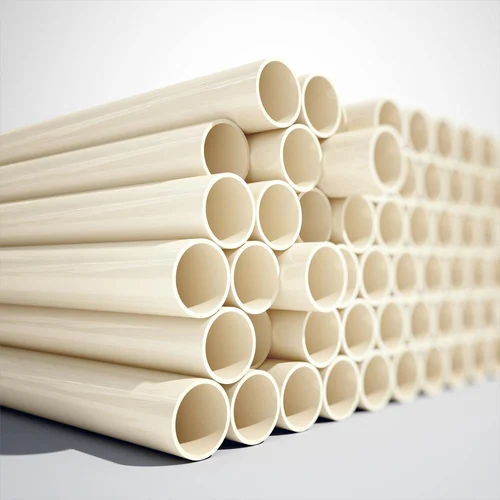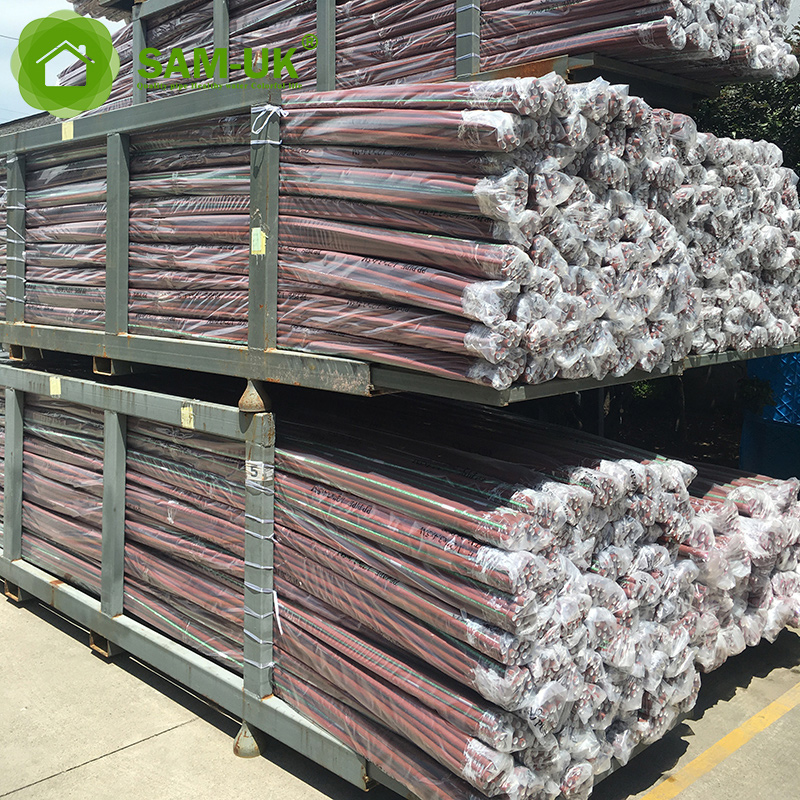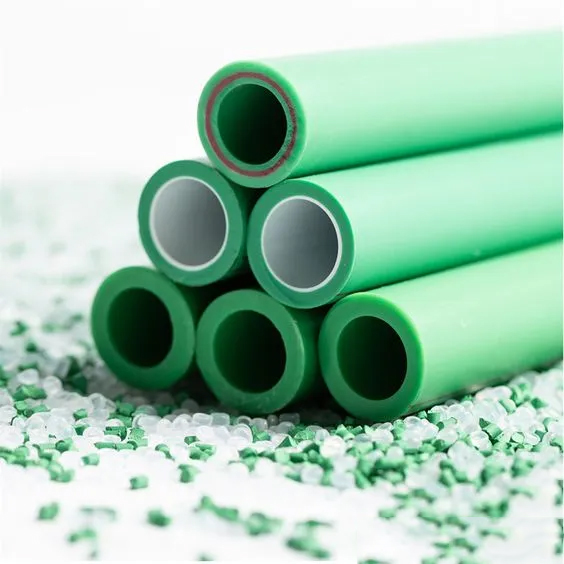Article Introduction
While metal pipes were once popular in plumbing, most new plumbing pipes today are plastic due to this material’s corrosion resistance. However, not all plastic pipe fittings are alike, and plumbers now have at least four types of plastic pipes and fittings they can use to make plumbing repairs. Each type of plastic plumbing pipe has its own unique advantages and disadvantages.
Learn about the four most popular types of plastic pipe in use today (PVC, CPVC, PPH, PPR) and the unique advantages and disadvantages of each pipe type by reading the following article.

PVC PIPE & FITTINGS
Polyvinyl chloride pipes and fittings are among the most common plastic plumbing system today. PVC pipes and fittings are affordable and durable and can stay in good condition as long as 70 years without developing rust or corrosion. This type is recyclable when it reaches the end of its lifespan, which makes it an environmentally friendly material.
In addition, unlike some plastic pipe fittings types, PVC pipes contain no bisphenol A (BPA), so they can create home water lines with little worry that the water that flows through them will become contaminated with this. These pipes and fittings are also versatile and easy to work with. PVC pipe sections can join together with a variety of pipe fittings, glues, and cements.
However, PVC pipes and fittings can become brittle over time when exposed to sunlight or installed in areas of the home that are often extremely hot. This pipe material’s lack of heat resistance makes it a poor choice for use when constructing or replacing hot water lines.
Advantages and disadvantages of PVC pipes
1. Advantages
- Strong corrosion resistance: Can resist corrosion from most acids, alkalis and salts, suitable for chemical, sewage treatment and other environments.
- Light weight and easy installation: PVC pipes have a lower density and are lighter in weight, making them easier to transport and install than metal pipes, reducing construction costs.
- Low fluid resistance: The inner wall is smooth, not easy to scale, and has low water flow resistance, which improves transportation efficiency.
- Good insulation performance: It has excellent electrical insulation and can be used as a protective pipe for wires and cables.
- Strong weather resistance: Can be exposed to sunlight and rain for a long time, not easy to age, and has a long service life.
- Economic price: Compared with metal pipes (such as copper pipes and stainless steel pipes), PVC pipes are inexpensive and cost-effective.
- Good pressure resistance: A properly designed PVC pipe can withstand higher water pressure and is suitable for water supply and drainage systems.
2. Disadvantages
- Poor high temperature resistance: PVC pipes are prone to softening or deformation in high temperature environments (generally over 60°C) and are not suitable for high temperature fluid transportation.
- Low impact resistance: PVC pipes tend to become brittle in low temperature environments and may break when impacted by external forces.
- Environmental impact: Hazardous substances such as hydrogen chloride (HCl) and plasticizers (some types of PVC contain phthalate plasticizers) may be released during the production and disposal of PVC.
- Poor recyclability: The recycling and reuse of PVC materials is more complicated and may contain additives, which limits their recycling.
- Limited connection methods: PVC pipes are usually glued or hot-melt connected, which is slightly inferior in strength and sealing compared to threaded or welded connections of metal pipes.
- Susceptible to UV rays: Long-term exposure to sunlight may cause aging, discoloration or brittleness, so anti-ultraviolet (UV) stabilizers need to be added for outdoor use.
CPVC PIPE & FITTINGS
Chlorinated polyvinyl chloride (CPVC) pipes are PVC pipes with a special chlorinated coating. This chlorinated coating increases the durability of the pipes by increasing their heat resistance. For this reason, CPVC pipes and fittings can repair and create drinking water lines, including hot water lines, without the worry that the pipes will become brittle over time with exposure to high heat.
However, CPVC pipes and fittings are slightly more costly than their PVC alternatives, and the lifespan of this pipe type is about 20 to 25 years.
Advantages and disadvantages of CPVC pipes
1. Advantages
- Excellent high temperature resistance: CPVC has a wider temperature resistance range than PVC, and can withstand hot water or chemical fluids at 90℃~110℃, which is suitable for hot water pipes and industrial uses. More suitable for hot water transportation than ordinary PVC (PVC pipes generally do not exceed 60℃).
- Strong corrosion resistance: It can resist the erosion of acids, alkalis, salts and most chemical solvents, and is particularly suitable for the chemical industry, industrial fluid transportation and other fields. In water supply systems and fire protection pipelines, it can prevent chlorine and chemicals in the water from corroding the pipeline.
- Higher mechanical strength: Compared with PVC, CPVC has higher strength and pressure resistance. Under the condition of the same wall thickness, it can withstand greater water pressure and is suitable for high-pressure pipeline systems.
- Low thermal expansion coefficient: In an environment with large temperature changes, CPVC pipes have better dimensional stability, are not easy to deform or shrink, and help to increase the service life of the pipeline system.
- Stronger flame retardancy: CPVC itself is not easy to burn, and does not produce a large amount of toxic gases when burning. It is suitable for fire protection systems and environments with high safety requirements.
- Convenient construction: CPVC pipes are similar to PVC and can be connected by solvent bonding or hot melt. The construction method is simple and reliable, and the maintenance cost is low.
2. Disadvantages
- Higher cost: The production process of CPVC is more complicated than PVC, and the price is higher. It is 30%~50% more expensive than PVC pipes, but still cheaper than metal pipes. It is suitable for projects with special requirements (such as high temperature resistance and corrosion resistance), but in general uses (such as ordinary cold water pipes), it may not be as economical as PVC.
- Easy to become brittle in low temperature environment: Below 0℃, the toughness of CPVC pipes will decrease, and it is easy to crack, which is not suitable for long-term use in extremely cold environments.
- Special solvent bonding is required: The connection of CPVC pipes requires the use of special solvent glue or welding technology. Compared with the versatility of PVC, more professional materials and techniques are required during construction.
- Color and appearance restrictions: CPVC pipes are usually light yellow or off-white, unlike PVC, which can be selected in a variety of colors. They may not be very beautiful in some occasions.
- Affected by ultraviolet rays, outdoor use requires protection: CPVC pipes may age if exposed to sunlight for a long time, and need to be coated with anti-ultraviolet coatings or wrapped with insulation materials for protection.
PPH PIPE & FITTINGS
PPH pipes are made from a high-quality thermoplastic polymer, which is known for its excellent chemical and thermal resistance. It is also lightweight and easy to install, making it an ideal option for a wide range of applications, including hot and cold water supply systems, radiant heating systems, and many other industrial and residential uses.
Advantages and disadvantages of PPH pipes
1. Advantages
- Extremely strong corrosion resistance: It can resist corrosion by most acids, alkalis, salts, solvents and other chemical substances, and is suitable for chemical industry, acid and alkali transportation, wastewater treatment and other occasions. It is more resistant to strong acids and alkalis than PVC and CPVC, especially suitable for high-concentration acid and alkali transportation (such as sulfuric acid, sodium hydroxide, etc.).
- Good high temperature resistance: PPH pipes can withstand temperatures of 90℃-110℃, which is more resistant to high temperatures than ordinary PP, and is suitable for hot fluid transportation. It is suitable for applications such as hot water pipelines and chemical high-temperature fluids, but not as high-temperature resistant as fluoroplastic pipes such as PVDF and PFA.
- High mechanical strength and strong impact resistance: PPH after β modification is more impact-resistant and pressure-resistant than ordinary PP pipes, and can maintain good toughness even in low temperature environments (such as 0℃), and is not easy to crack. It has stronger impact resistance than PVC and CPVC, and is more stable in industrial environments.
- Smooth inner wall and low fluid resistance: The inner wall of the PPH pipe is smooth, which reduces fluid resistance, is not easy to scale, and improves transportation efficiency. It is especially suitable for applications such as high-purity water transportation and sewage treatment.
- Non-toxic and harmless, in line with food grade standards: PPH pipes do not contain plasticizers, are non-toxic and harmless, meet food grade and medical grade requirements, and can be used in pharmaceutical, food processing, pure water systems and other fields.
- Lightweight and easy to install: low density (about 0.91g/cm³), lighter than PVC and CPVC, easier to install and transport, and low construction cost. Hot melt welding, flange connection and other methods can be used, with stable connection and good sealing.
- Good weather resistance and long service life: PPH material is not easy to age under outdoor exposure conditions, better weather resistance than PVC, and has a service life of more than 50 years (under appropriate working conditions).
2. Disadvantages
- Limited temperature resistance (worse than PVDF, PFA, etc.): The maximum operating temperature is about 110℃, but it is easy to soften or deform above this temperature, so it is not suitable for extremely high temperature environments (such as industrial pipes above 200℃). Slightly better than CPVC in high temperature resistance, but not as good as fluoroplastic pipes such as PVDF and PTFE.
- May become brittle in low temperature environment: Below 5℃, the toughness of PPH pipes will decrease. Although β modification enhances impact resistance, it is still not suitable for extremely cold areas. Insulation treatment is required in cold areas, otherwise brittle cracking is prone to occur.
- High connection requirements: Hot melt welding or butt welding technology is required, and the construction requirements are higher than PVC pipes, and the technical requirements for construction personnel are higher. It cannot be bonded by solvents like PVC, and the construction cost is relatively high.
- Higher price than PVC and CPVC: More expensive than PVC, close to CPVC, but cheaper than high-end plastic pipes such as PVDF and PFA. Suitable for industrial fields that require chemical resistance, temperature resistance, and impact resistance, while for general applications (such as building water supply and drainage), PVC/CPVC may be more economical.
- Sensitive to UV rays, need protection: Long-term exposure to UV rays may cause aging, so outdoor use requires anti-UV coating or protective cover. Better weather resistance than PVC, but not as good as high-end plastic pipes such as PVDF.
PPR PIPE & FITTINGS
Polypropylene (PP) is a versatile piping material that is used in a wide range of applications. Two types of PP are used for pressure piping systems: PP-R (polypropylene random copolymer) and PP-RCT (polypropylene random copolymer with modified crystallinity and temperature resistance). With their high temperature and pressure capabilities, PP-R pipes and fittings are suitable for demanding pressure piping applications, such as pressure piping (plumbing, hydronics) in commercial high-rise buildings.
Advantages and disadvantages of PPR pipes
1. Advantages
- Excellent high temperature resistance: PPR pipes can withstand temperatures up to 95°C and can withstand 110°C for a short time, making them suitable for hot water pipes and heating systems. They are more resistant to high temperatures than PVC pipes, but lower than high-performance plastics such as PVDF and PFA.
- Strong corrosion resistance: They can resist most acids, alkalis, salts and common chemical solvents, are not easy to scale or rust, and will not affect water quality after long-term use. They are more corrosion-resistant than metal pipes (such as galvanized pipes and copper pipes) and are more suitable for long-term drinking water transportation.
- Non-toxic and harmless, environmentally friendly and healthy: PPR materials do not contain plasticizers, are non-toxic and tasteless, meet food-grade hygiene standards, and can be directly used for drinking water transportation. They will not precipitate harmful substances, avoid secondary pollution, and are suitable for medical and food industries.
- High mechanical strength and good pressure resistance: They can withstand a working pressure of 1.25MPa-2.5MPa at room temperature and can be used in high-pressure water supply systems. They are more impact-resistant than PVC and CPVC, are not easy to crack, and have stable performance in low temperature environments.
- Convenient construction and reliable connection: hot-melt welding connection, the joint and the pipe are integrated to prevent leakage and have a long service life. It is safer and more sealed than the glue bonding method of PVC pipes, and is not affected by solvent aging.
- Insulation and energy saving, low thermal conductivity: The thermal conductivity of PPR pipes is only 0.24W/(m·K), which is 200 times lower than that of metal pipes. It has good thermal insulation performance, reduces heat energy loss, and is suitable for hot water pipes and heating systems. It is not easy to condense, reducing the problem of water drop condensation caused by the temperature difference between hot and cold water.
- Good weather resistance and long service life: It can reach more than 50 years under normal use conditions, which is longer than the life of metal pipes. It is not corroded by chloride ions in water and is suitable for long-term drinking water transportation.
2. Disadvantages
- Toughness deteriorates at low temperatures and is prone to brittle cracking: Below **-5℃**, the toughness of PPR pipes will decrease, and they are prone to brittle cracking, making them unsuitable for use in extremely cold environments. Insulation measures are required or special cold-resistant PPR pipes should be used.
- Cannot be exposed to ultraviolet rays for a long time: PPR materials are not resistant to ultraviolet rays, and will age, discolor, and become brittle if exposed to the sun for a long time. It is necessary to add a protective layer or bury it in a pipe well.
- The connection method has high requirements for construction technology: PPR pipes are welded by hot melt welding, and a special hot melt machine is required. Construction personnel must master the correct welding technology, otherwise it is easy to cause loose welding or leakage. Compared with the solvent bonding method of PVC, the construction is slightly more complicated and the labor cost is higher.
- The price is higher than PVC, but lower than CPVC and PVDF: The cost of PPR is slightly higher than PVC, and cheaper than CPVC and PVDF, but due to its durability and environmental protection, the cost performance is still high.
- Cannot be used for conveying strong acid, strong alkali or special chemical media: Although PPR has strong chemical resistance, it is not as good as high-performance plastics such as PPH and PVDF, and cannot be used for conveying special fluids such as concentrated sulfuric acid and strong oxidants.
Summarize
In daily life, different plastic pipes are suitable for different scenarios, and appropriate materials should be selected based on temperature requirements, pressure requirements, corrosion resistance and other factors:
- Household hot and cold water pipes → PPR/PPR-CT
- Industrial corrosive fluids → PPH/CPVC
- Gas transportation → PE
- Economical drainage pipes → PVC
- High temperature and extreme chemical environments → PVDF
SAM-UK are a leading CHINA factory of PVC, CPVC, PPH and PPR pipes and fittings. We have been supplying industrial plastic pipe systems offline since 2007. Our sales team have great product knowledge when it comes to the parts we supply. This means they are only too happy to provide guidance on the assembly of our parts and any technical specifications you may need to know before you plan your project.

About SAM-UK
SAM-UK are a professional 18+ years manufacturer in producing vinyl building profile products and PVC , CPVC , PPH , PPR , PP pipes and pipe fittings, valves, taps and so on. We own the certificates of SGS\SONCAP\ISO9001\CE\NSF,support color /size customization. Welcome to consult for Catalog and Product. you can contact us at email [email protected]









